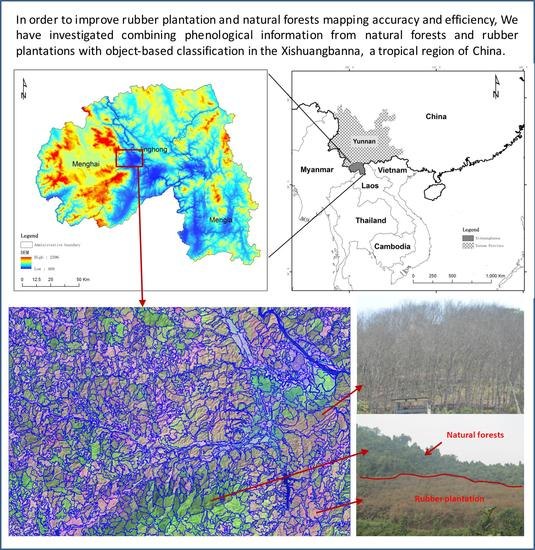Comparison of Pixel- and Object-Based Approaches in Phenology-Based Rubber Plantation Mapping in Fragmented Landscapes
Abstract
:1. Introduction
2. Materials and Methods
2.1. Study Area
2.2. Data Used and Preprocessing
2.2.1. Modis Data
2.2.2. Landsat Data
2.2.3. Training and Validation Data Collection and Field Observations of Rubber Plantation Phenology
2.3. Mapping Rubber Plantations Using Phenology at Regional Scale
2.3.1. Decision Rule
2.3.2. Rule-Pixel-Based Phenology Approach
2.3.3. Rule-Object-Based Phenology Approach
2.3.4. Nearest-Neighbor-Object-Based Phenology Approach
2.4. Validation and Comparison
3. Results
3.1. Rubber Plantation Phenology Characteristics in Xishuangbanna
3.2. Rubber Plantation Map in Xishuangbanna and Accuracy Assessment
4. Discussion
4.1. Performance of the Phenology-Based Approach for Rubber Plantation
4.2. Comparison of Object- vs. Pixel-Based Approaches in Phenology-Based Mapping
4.4. Implication of Extensive Application
4.5. Uncertainties of Rubber Plantation Mapping
5. Conclusions
Supplementary Materials
Acknowledgments
Author Contributions
Conflicts of Interest
References
- Koh, L.P.; Wilcove, D.S. Is oil palm agriculture really destroying tropical biodiversity? Conserv. Lett. 2008, 1, 60–64. [Google Scholar] [CrossRef]
- Ziegler, A.D.; Fox, J.M.; Xu, J.C. The rubber juggernaut. Science 2009, 324, 1024–1025. [Google Scholar] [CrossRef] [PubMed]
- Food and Agriculture Organization (FAO). Global Forest Resources Assessment 2010; FAO Forestry Paper; FAO: Rome, Italy, 2010. [Google Scholar]
- Li, Z.; Fox, J.M. Mapping rubber tree growth in mainland southeast Asia using time-series MODIS 250 m NDVI and statistical data. Appl. Geogr. 2012, 32, 420–432. [Google Scholar] [CrossRef]
- Prachaya, J. London and Bangkok; Rubber Economist Quarterly Report; The Rubber Economist Ltd.: Bangkok, Thailand, 2009. [Google Scholar]
- Fox, J.; Vogler, J.B. Land-use and land-cover change in montane mainland Southeast Asia. Environ. Manag. 2005, 36, 394–403. [Google Scholar] [CrossRef] [PubMed]
- Zhai, D.-L.; Cannon, C.H.; Slik, J.W.F.; Zhang, C.-P.; Dai, Z.-C. Rubber and pulp plantations represent a double threat to Hainan’s natural tropical forests. J. Environ. Manag. 2012, 96, 64–73. [Google Scholar] [CrossRef] [PubMed]
- Xu, J.C.; Ma, E.T.; Tashi, D.; Fu, Y.S.; Lu, Z.; Melick, D. Integrating sacred knowledge for conservation: Cultures and landscapes in southwest China. Ecol. Soc. 2005, 10, 7. [Google Scholar] [CrossRef]
- Sturgeon, J.C. Cross-border rubber cultivation between China and Laos: Regionalization by Akha and Tai rubber farmers. Singap. J. Trop. Geogr. 2013, 34, 70–85. [Google Scholar] [CrossRef]
- Fu, Y.; Chen, J.; Guo, H.; Hu, H.; Chen, A.; Cui, J. Agrobiodiversity loss and livelihood vulnerability as a consequence of converting from subsistence farming systems to commercial plantation-dominated systems in Xishuangbanna, Yunnan, China: A household level analysis. Land Degrad. Dev. 2010, 21, 274–284. [Google Scholar] [CrossRef]
- Guardiola-Claramonte, M.; Troch, P.A.; Ziegler, A.D.; Giambelluca, T.W.; Durcik, M.; Vogler, J.B.; Nullet, M.A. Hydrologic effects of the expansion of rubber (Hevea brasiliensis) in a tropical catchment. Ecohydrology 2010, 3, 306–314. [Google Scholar] [CrossRef]
- Li, H.M.; Ma, Y.X.; Aide, T.M.; Liu, W.J. Past, present and future land-use in Xishuangbanna, China and the implications for carbon dynamics. For. Ecol. Manag. 2008, 255, 16–24. [Google Scholar] [CrossRef]
- Xu, J.; Grumbine, R.E.; Beckshafer, P. Landscape transformation through the use of ecological and socioeconomic indicators in Xishuangbanna, Southwest China, Mekong region. Ecol. Indic. 2014, 36, 749–756. [Google Scholar] [CrossRef]
- Qiu, J. Where the rubber meets the garden. Nature 2009, 457, 246–247. [Google Scholar] [CrossRef] [PubMed]
- Grogan, K.; Pflugmacher, D.; Hostert, P.; Kennedy, R.; Fensholt, R. Cross-border forest disturbance and the role of natural rubber in mainland Southeast Asia using annual Landsat time series. Remote Sens. Environ. 2015, 169, 438–453. [Google Scholar] [CrossRef]
- Li, H.M.; Aide, T.M.; Ma, Y.X.; Liu, W.J.; Cao, M. Demand for rubber is causing the loss of high diversity rain forest in SW China. Biodivers. Conserv. 2007, 16, 1731–1745. [Google Scholar] [CrossRef]
- Liu, X.; Feng, Z.; Jiang, L. Application of decision tree classification to rubber plantations extraction with remote sensing. Trans. Chin. Soc. Agric. Eng. 2013, 29, 163–172. [Google Scholar]
- Liu, X.; Feng, Z.; Jiang, L.; Zhang, J. Rubber plantations in Xishuangbanna: Remote sensing identification and digital mapping. Resour. Sci. 2012, 34, 1769–1780. [Google Scholar]
- Dong, J.; Xiao, X.; Chen, B.; Torbick, N.; Jin, C.; Zhang, G.; Biradar, C. Mapping deciduous rubber plantations through integration of PALSAR and multi-temporal Landsat imagery. Remote Sens. Environ. 2013, 134, 392–402. [Google Scholar] [CrossRef]
- Li, Z.; Fox, J.M. Integrating mahalanobis typicalities with a neural network for rubber distribution mapping. Remote Sens. Lett. 2011, 2, 157–166. [Google Scholar] [CrossRef]
- Chen, H.; Chen, X.; Chen, Z.; Zhu, N.; Tao, Z. A primary study on rubber acreage estimation from modis-based information in Hainan. Chin. J. Trop. Crops 2010, 31, 1181–1185. [Google Scholar]
- Dong, J.; Xiao, X.; Sheldon, S.; Biradar, C.; Duong, N.D.; Hazarika, M. A comparison of forest cover maps in mainland Southeast Asia from multiple sources: PALSAR, MERIS, MODIS and FRA. Remote Sens. Environ. 2012, 127, 60–73. [Google Scholar] [CrossRef]
- Senf, C.; Pflugmacher, D.; van der Linden, S.; Hostert, P. Mapping rubber plantations and natural forests in Xishuangbanna (Southwest China) using multi-spectral phenological metrics from MODIS time series. Remote Sens. 2013, 5, 2795–2812. [Google Scholar] [CrossRef]
- Cheng, G.; Han, J.; Guo, L.; Liu, Z.; Bu, S.; Ren, J. Effective and efficient midlevel visual elements-oriented land-use classification using VHR remote sensing images. IEEE Trans. Geosci. Remote Sens. 2015, 53, 4238–4249. [Google Scholar] [CrossRef]
- Cheng, G.; Guo, L.; Zhao, T.; Han, J.; Li, H.; Fang, J. Automatic landslide detection from remote-sensing imagery using a scene classification method based on BoVW and pLSA. Int. J. Remote Sens. 2013, 34, 45–59. [Google Scholar] [CrossRef]
- Cheng, G.; Han, J.; Zhou, P.; Guo, L. Multi-class geospatial object detection and geographic image classification based on collection of part detectors. ISPRS J. Photogramm. Remote Sens. 2014, 98, 119–132. [Google Scholar] [CrossRef]
- Mittermeier, R.A.; Gil, P.R.; Hoffman, M.; Pilgrim, J.; Brooks, T.; Mittermeier, C.G.; Lamoreux, J.; da Fonseca, G.A.B. Hotspots Revisited: Earth’s Biologically Richest and Most Endangered Terrestrial Ecoregions; Conservation International: Hongkong, China, 2005. [Google Scholar]
- Zhu, H.; Cao, M.; Hu, H.B. Geological history, flora, and vegetation of Xishuangbanna, Southern Yunnan, China. Biotropica 2006, 38, 310–317. [Google Scholar] [CrossRef]
- Liu, W.J.; Liu, W.Y.; Li, P.J.; Gao, L.; Shen, Y.X.; Wang, P.Y.; Zhang, Y.P.; Li, H.M. Using stable isotopes to determine sources of fog drip in a tropical seasonal rain forest of Xishuangbanna, SW China. Agric. For. Meteorol. 2007, 143, 80–91. [Google Scholar] [CrossRef]
- Song, Q.; Lin, H.; Zhang, Y.; Tan, Z.; Zhao, J.; Zhao, J.; Zhang, X.; Zhou, W.; Yu, L.; Yang, L.; et al. The effect of drought stress on self-organization in a seasonal tropical rainforest. Ecol. Model. 2013, 265, 136–139. [Google Scholar] [CrossRef]
- Xu, J. The political, social, and ecological transformation of a landscape—The case of rubber in Xishuangbanna, China. Mt. Res. Dev. 2006, 26, 254–262. [Google Scholar]
- Guardiola-Claramonte, M.; Troch, P.A.; Ziegler, A.D.; Giambelluca, T.W.; Vogler, J.B.; Nullet, M.A. Local hydrologic effects of introducing non-native vegetation in a tropical catchment. Ecohydrology 2008, 1, 13–22. [Google Scholar] [CrossRef]
- Roy, D.P.; Wulder, M.A.; Loveland, T.R.; Allen, R.G.; Anderson, M.C.; Helder, D.; Irons, J.R.; Johnson, D.M.; Kennedy, R.; Scambos, T.A.; et al. Landsat-8: Science and product vision for terrestrial global change research. Remote Sens. Environ. 2014, 145, 154–172. [Google Scholar] [CrossRef]
- Wulder, M.A.; White, J.C.; Goward, S.N.; Masek, J.G.; Irons, J.R.; Herold, M.; Cohen, W.B.; Loveland, T.R.; Woodcock, C.E. Landsat continuity: Issues and opportunities for land cover monitoring. Remote Sens. Environ. 2008, 112, 955–969. [Google Scholar] [CrossRef]
- Masek, J.G.; Vermote, E.F.; Saleous, N.E.; Wolfe, R.; Hall, F.G.; Huemmrich, K.F.; Gao, F.; Kutler, J.; Lim, T.K. A Landsat surface reflectance dataset for North America, 1990–2000. IEEE Geosci. Remote Sens. Lett. 2006, 3, 68–72. [Google Scholar] [CrossRef]
- Vermote, E.F.; El Saleous, N.; Justice, C.O.; Kaufman, Y.J.; Privette, J.L.; Remer, L.; Roger, J.C.; Tanré, D. Atmospheric correction of visible to middle-infrared EOS-MODIS data over land surfaces: Background, operational algorithm and validation. J. Geophys. Res. 1997, 102, 17131–17141. [Google Scholar] [CrossRef]
- Xiao, X.; Biradar, C.M.; Czarnecki, C.; Alabi, T.; Keller, M. A simple algorithm for large-scale mapping of evergreen forests in tropical America, Africa and Asia. Remote Sens. 2009, 1, 355–374. [Google Scholar] [CrossRef]
- Tucker, C.J. Red and photographic infrared linear combinations for monitoring vegetation. Remote Sens. Environ. 1979, 8, 127–150. [Google Scholar] [CrossRef]
- Huete, A.; Didan, K.; Miura, T.; Rodriguez, E.P.; Gao, X.; Ferreira, L.G. Overview of the radiometric and biophysical performance of the MODIS vegetation indices. Remote Sens. Environ. 2002, 83, 195–213. [Google Scholar] [CrossRef]
- Xiao, X.; Hollinger, D.; Aber, J.; Goltz, M.; Davidson, E.A.; Zhang, Q.; Moore Iii, B. Satellite-based modeling of gross primary production in an evergreen needleleaf forest. Remote Sens. Environ. 2004, 89, 519–534. [Google Scholar] [CrossRef]
- Potere, D.; Feierabend, N.; Strahler, A.H.; Bright, E.A. Wal-Mart from space: A new source for land cover change validation. Photogramm. Eng. Remote Sens. 2008, 74, 913–919. [Google Scholar] [CrossRef]
- Kou, W.; Xiao, X.; Dong, J.; Gan, S.; Zhai, D.; Zhang, G.; Qin, Y.; Li, L. Mapping deciduous rubber plantation areas and stand ages with PALSAR and Landsat images. Remote Sens. 2015, 7, 1048–1073. [Google Scholar] [CrossRef]
- Benz, U.C.; Hofmann, P.; Willhauck, G.; Lingenfelder, I.; Heynen, M. Multi-resolution, object-oriented fuzzy analysis of remote sensing data for GIS-ready information. ISPRS J. Photogramm. Remote Sens. 2004, 58, 239–258. [Google Scholar] [CrossRef]
- Bajocco, S.; Dragoz, E.; Gitas, I.; Smiraglia, D.; Salvati, L.; Ricotta, C. Mapping forest fuels through vegetation phenology: The role of coarse-resolution satellite time-series. PLoS ONE 2015, 10, e0119811. [Google Scholar] [CrossRef] [PubMed]
- Kavzoglu, T.; Yildiz, M. Parameter-based performance analysis of object-based image analysis using aerial and Quikbird-2 images. ISPRS J. Photogramm. Remote Sens. 2014, 2, 31–37. [Google Scholar] [CrossRef]
- Mallinis, G.; Koutsias, N.; Tsakiri-Strati, M.; Karteris, M. Object-based classification using Quickbird imagery for delineating forest vegetation polygons in a Mediterranean test site. ISPRS J. Photogramm. Remote Sens. 2008, 63, 237–250. [Google Scholar] [CrossRef]
- Liu, D.; Xia, F. Assessing object-based classification: Advantages and limitations. Remote Sens. Lett. 2010, 1, 187–194. [Google Scholar] [CrossRef]
- Li, P.; Zhang, J.; Feng, Z. Mapping rubber tree plantations using a Landsat-based phenological algorithm in Xishuangbanna, Southwest China. Remote Sens. Lett. 2015, 6, 49–58. [Google Scholar] [CrossRef]
- Fan, H.; Fu, X.H.; Zhang, Z.; Wu, Q. Phenology-based vegetation index differencing for mapping of rubber plantations using Landsat OLI data. Remote Sens. 2015, 7, 6041–6058. [Google Scholar] [CrossRef]
- Liu, J.-J.; Slik, J.W.F. Forest fragment spatial distribution matters for tropical tree conservation. Biol. Conserv. 2014, 171, 99–106. [Google Scholar] [CrossRef]
- Zhai, D.L.; Yu, H.Y.; Chen, S.C.; Ranjitkar, S.; Xu, J.C. Response of rubber leaf phenology to climatic variations in southwest China. Int. J. Biometeorol. 2017. [Google Scholar] [CrossRef] [PubMed]
- Tan, Z.; Zhang, Y.; Song, Q.; Yu, G.; Liang, N. Leaf shedding as an adaptive strategy for water deficit: A case study in XIshuangbannas rainforest. J. Yunnan Univ. 2014, 36, 273–280. [Google Scholar]
- Priyadarshan, P. Biology of Hevea Rubber; Springer: Berlin, Germnay, 2011. [Google Scholar]


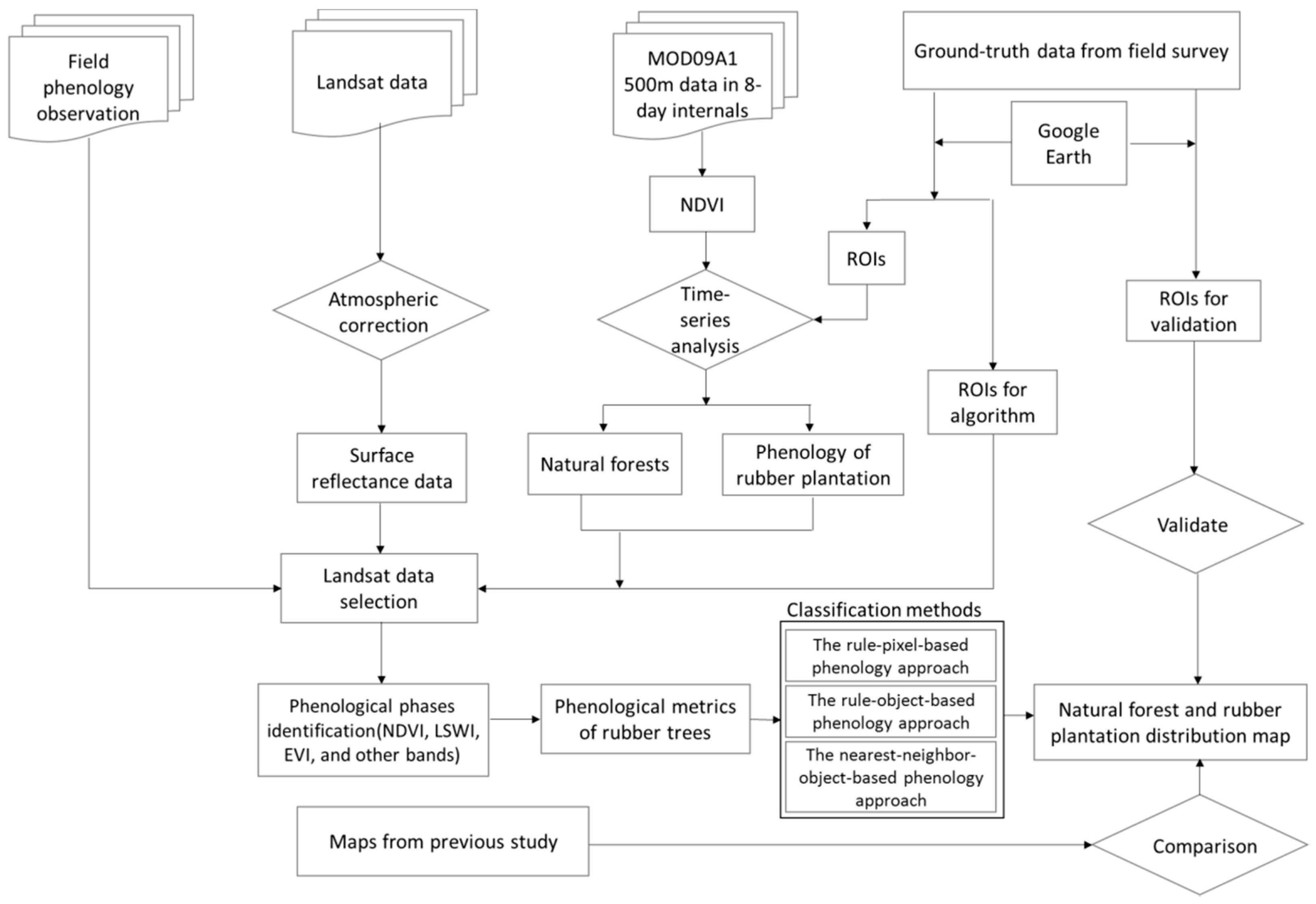
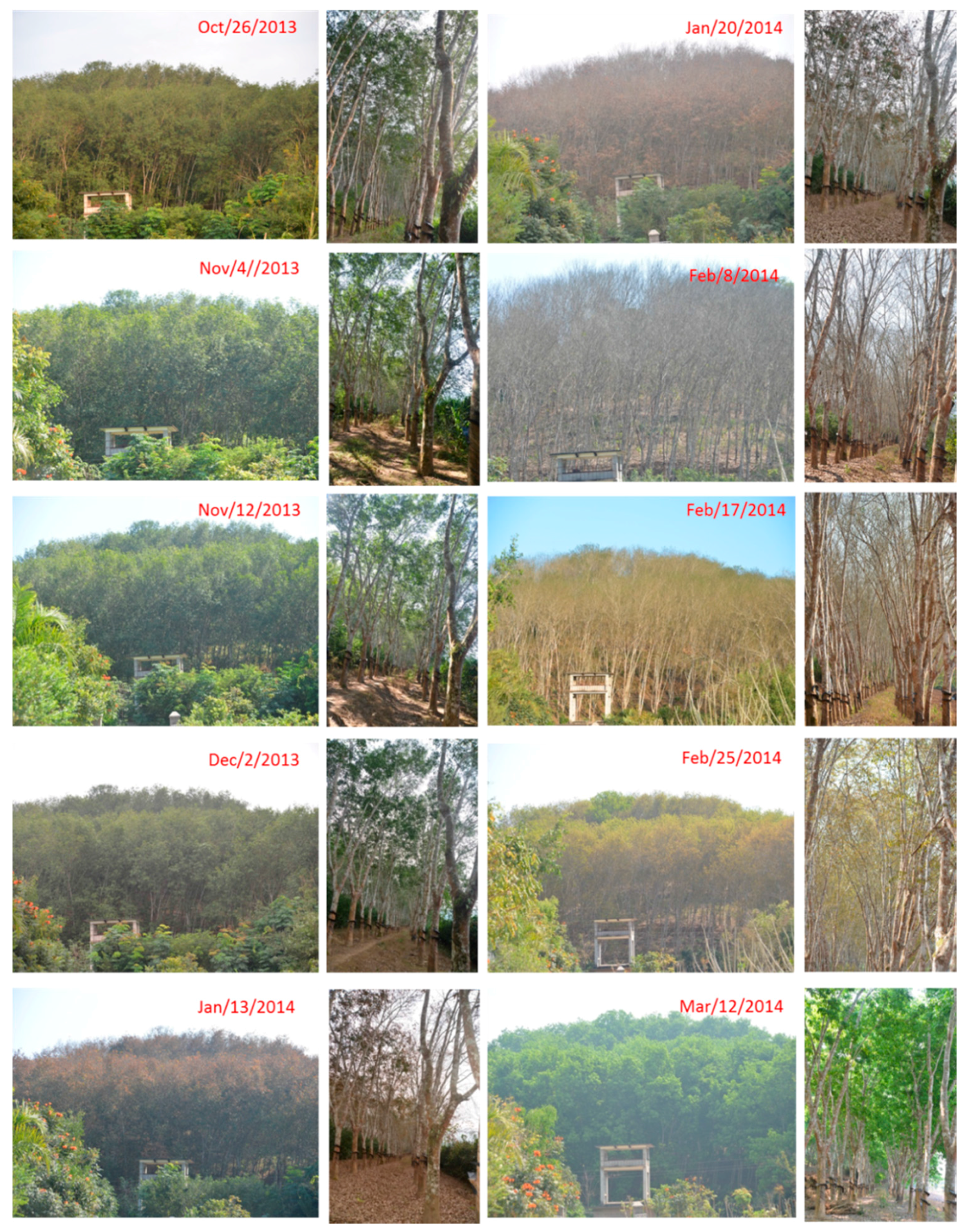
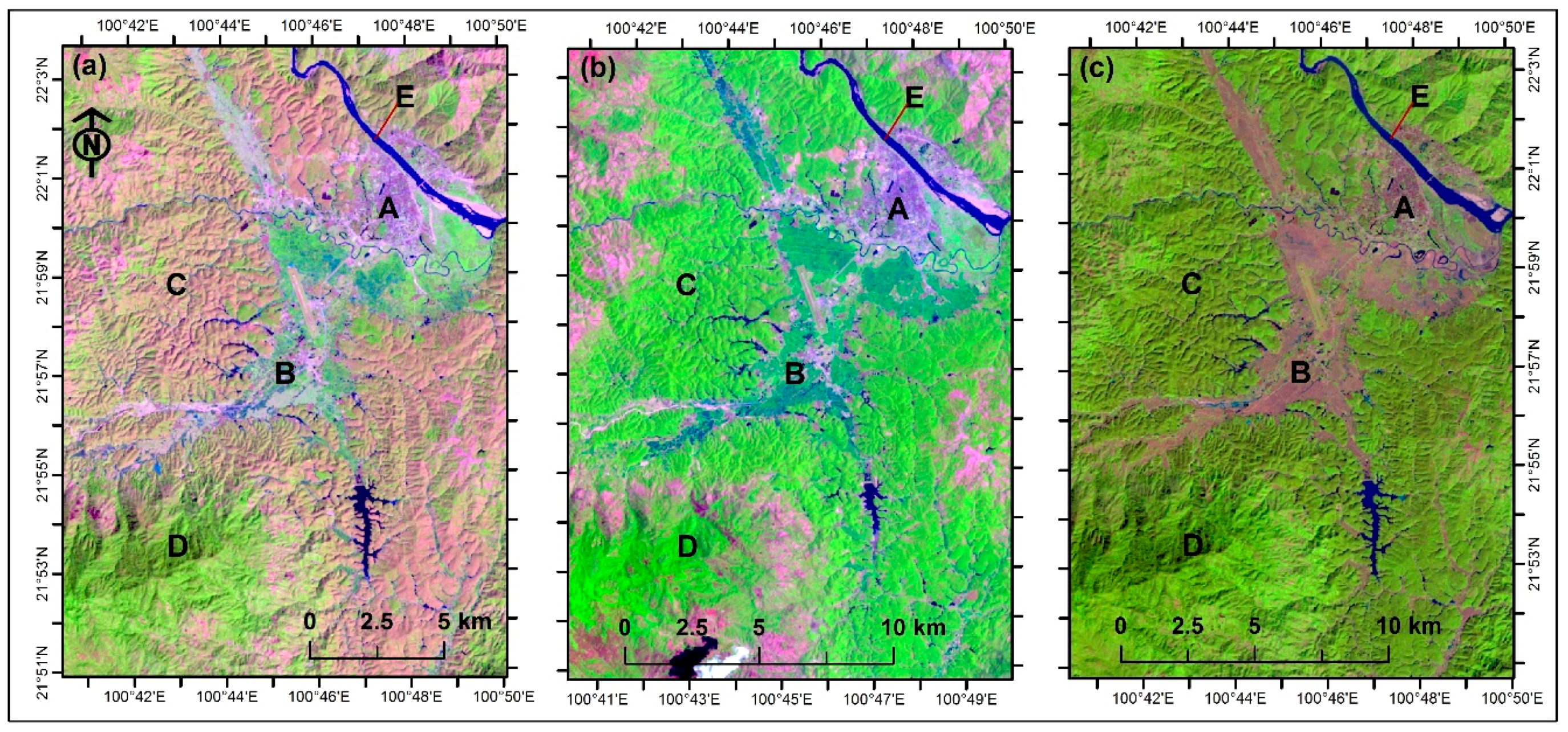



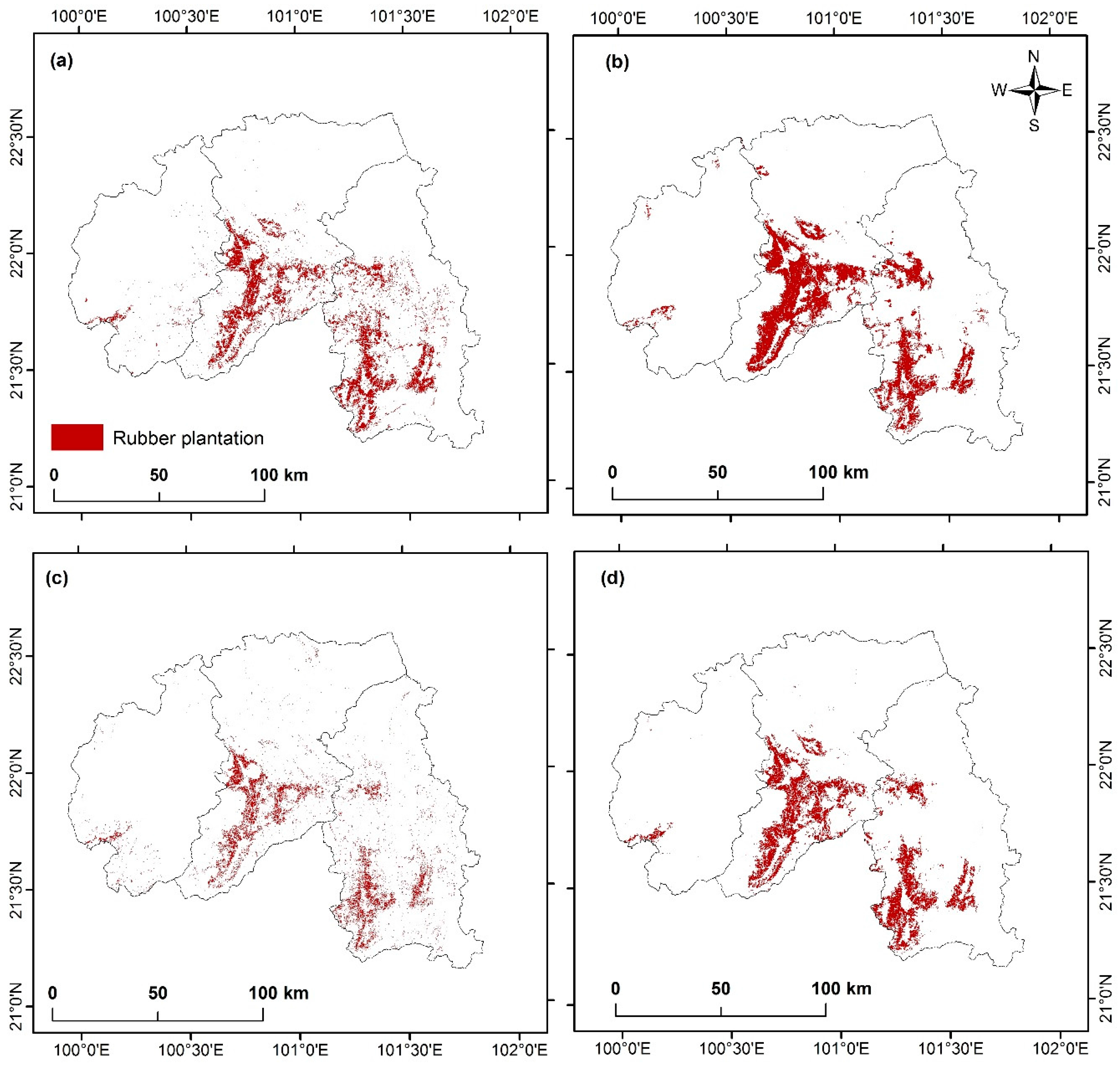
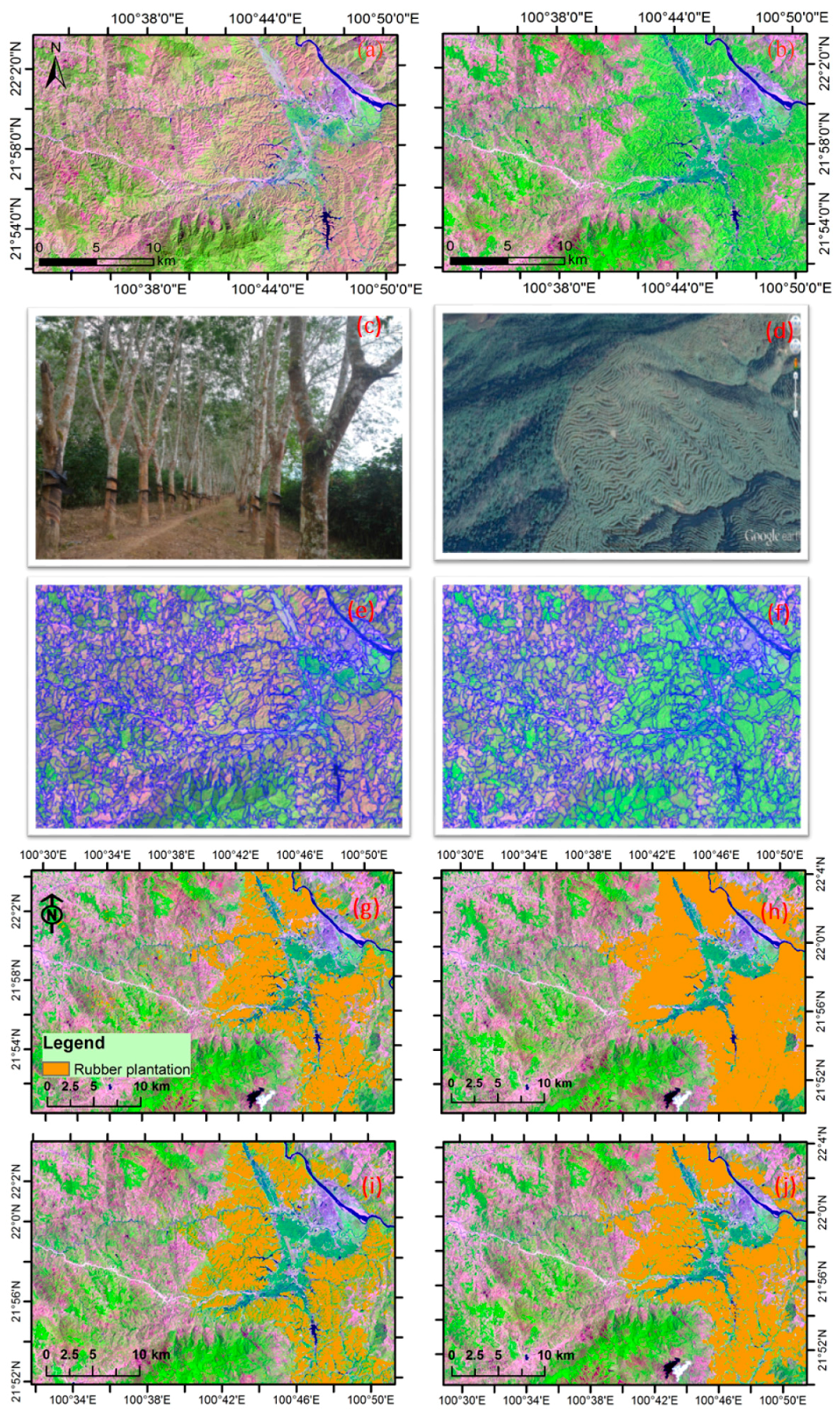
| Acquired Data | DOY | Sensor | Acquired Year |
|---|---|---|---|
| January 7 | 7 | Landsat 5 TM | 2002 |
| January 26 | 26 | Landsat 5 TM | 2003 |
| February 8 | 39 | Landsat 5 TM | 2002 |
| February 11 | 42 | Landsat 5 TM | 2003 |
| February 19 | 50 | Landsat 7 ETM+ | 2003 |
| February 28 | 59 | Landsat 5 TM | 2003 |
| March 4 | 63 | Landsat 7 ETM+ | 2002 |
| March 28 | 87 | Landsat 5 TM | 2002 |
| April 8 | 98 | Landsat 7 ETM+ | 2002 |
| April 21 | 111 | Landsat 7 ETM+ | 2002 |
| April 29 | 119 | Landsat 5 TM | 2002 |
| Multi-Resolution Segmentation | Classification | |||||
|---|---|---|---|---|---|---|
| Segment level | Scale | Shape | Compactness | Classes | Rule-object-based phenology approach | Nearest-neighbor-object-based phenology approach |
| Level 1 | 20 | 0.1 | 0.5 | Vegetation/Non-vegetation | Nearest Neighbor classifier | |
| Nodata | Membership Function classifier | |||||
| Level 2 | 10 | 0.1 | 0.5 | Natural forests/Rubber Plantations | Decision tree classifier | Nearest Neighbor classifier |
| Waterbodies/Other land use types Nodata | Membership Function classifier | Membership Function classifier | ||||
| (A) | ||||||
| The Rule-Pixel-Based Phenology Approach | Class | Ground-Truth (Pixels) | Total Classified Pixels | User’s Accuracy | ||
| Natural Forest | Rubber | Others | ||||
| Classified results | Natural forest | 130 | 80 | 16 | 226 | 57.5% |
| Rubber | 7 | 56 | 0 | 63 | 88.9% | |
| Others | 7 | 8 | 128 | 143 | 89.5% | |
| Total ground truth pixels | 144 | 144 | 144 | 432 | ||
| Producer’s accuracy | 90.3% | 38.9% | 88.9% | |||
| Overall accuracy | 72.7% | |||||
| Kappa coefficient | 0.59 | |||||
| (B) | ||||||
| The Rule-Object-Based Phenology Approach | Classes | Ground-Truth (Pixels) | Total Classified Pixels | User’s Accuracy | ||
| Natural Forest | Rubber | Others | ||||
| Classified results | Natural forest | 137 | 53 | 6 | 196 | 69.9% |
| Rubber | 0 | 67 | 7 | 74 | 90.5% | |
| Others | 7 | 24 | 134 | 162 | 80.9% | |
| Total ground truth pixels | 144 | 144 | 144 | 432 | ||
| Producer’s accuracy | 95.1% | 46.5% | 90.1% | |||
| Overall accuracy | 77.5% | |||||
| Kappa coefficient | 0.66 | |||||
| (C) | ||||||
| The Nearest-Neighbor-Object-Based Approach | Classes | Ground-Truth (Pixels) | Total Classified Pixels | User’s Accuracy | ||
| Natural Forest | Rubber | Others | ||||
| Classified results | Natural forest | 139 | 8 | 5 | 152 | 91.4% |
| Rubber | 5 | 130 | 15 | 150 | 86.7% | |
| Others | 0 | 6 | 124 | 130 | 95.4% | |
| Total ground truth pixels | 144 | 144 | 144 | 432 | ||
| Producer’s accuracy | 96.5% | 90.3% | 86.1% | |||
| Overall accuracy | 91.0% | |||||
| Kappa coefficient | 0.86 | |||||
© 2017 by the authors. Licensee MDPI, Basel, Switzerland. This article is an open access article distributed under the terms and conditions of the Creative Commons Attribution (CC BY) license (http://creativecommons.org/licenses/by/4.0/).
Share and Cite
Zhai, D.; Dong, J.; Cadisch, G.; Wang, M.; Kou, W.; Xu, J.; Xiao, X.; Abbas, S. Comparison of Pixel- and Object-Based Approaches in Phenology-Based Rubber Plantation Mapping in Fragmented Landscapes. Remote Sens. 2018, 10, 44. https://doi.org/10.3390/rs10010044
Zhai D, Dong J, Cadisch G, Wang M, Kou W, Xu J, Xiao X, Abbas S. Comparison of Pixel- and Object-Based Approaches in Phenology-Based Rubber Plantation Mapping in Fragmented Landscapes. Remote Sensing. 2018; 10(1):44. https://doi.org/10.3390/rs10010044
Chicago/Turabian StyleZhai, Deli, Jinwei Dong, Georg Cadisch, Mingcheng Wang, Weili Kou, Jianchu Xu, Xiangming Xiao, and Sawaid Abbas. 2018. "Comparison of Pixel- and Object-Based Approaches in Phenology-Based Rubber Plantation Mapping in Fragmented Landscapes" Remote Sensing 10, no. 1: 44. https://doi.org/10.3390/rs10010044
APA StyleZhai, D., Dong, J., Cadisch, G., Wang, M., Kou, W., Xu, J., Xiao, X., & Abbas, S. (2018). Comparison of Pixel- and Object-Based Approaches in Phenology-Based Rubber Plantation Mapping in Fragmented Landscapes. Remote Sensing, 10(1), 44. https://doi.org/10.3390/rs10010044







